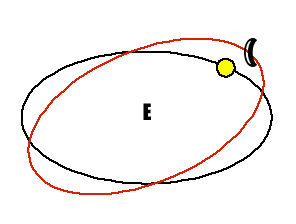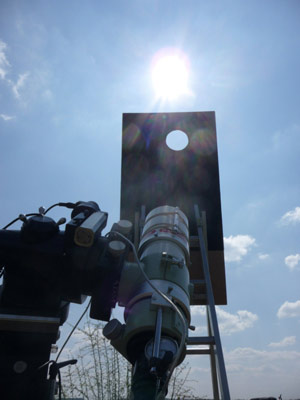Thierry Legault is a French amateur astronomer… and if ever the word “amateur” were misleading, it’s here. Thierry is an incredibly accomplished astronomer; his pictures have graced my blog many times in the past. Like when he caught the Shuttle and Hubble silhouetted against the Sun, or this lighthearted picture of someone painting the Sun, or the Shuttle and the space station transiting the Sun.
Come to think of it, he seems to have a fetish with the Sun. But that’s good, because he’s done it again: he’s captured a record-breaking picture of the newest new Moon!
It’s very hard to see, so I bracketed it with those red lines. Thierry caught the Moon when it was as absolutely close to the Sun as it could get at the time, so in fact this is the youngest Moon it could possibly be!
So what does that mean?
 Hopefully this terrible diagram I slapped together may help. Picture yourself on the Earth (that should be easy) marked by the E in the drawing. Once a day it appears that the Sun (yellow circle) circles the Earth (black path). The Moon (crescent symbol) circles the Earth once per month – well, it rises and sets every night, but relative to the Sun the Moon moves slowly across the sky. The Moon’s distance to the Sun changes so that at sunset every night, the Moon is in a noticeably different part of the sky than it was the night before.
Hopefully this terrible diagram I slapped together may help. Picture yourself on the Earth (that should be easy) marked by the E in the drawing. Once a day it appears that the Sun (yellow circle) circles the Earth (black path). The Moon (crescent symbol) circles the Earth once per month – well, it rises and sets every night, but relative to the Sun the Moon moves slowly across the sky. The Moon’s distance to the Sun changes so that at sunset every night, the Moon is in a noticeably different part of the sky than it was the night before.
New Moon is when the Moon and Sun are as close together as they can be, and it happens once per month or so. But since the Moon’s orbit is tilted, it doesn’t always pass directly in front of the Sun (creating a solar eclipse); it misses by a bit. But still, the Moon is so close to the Sun in the sky that we’re basically seeing the half of the Moon that’s unlit (the lit half is facing away from us, toward the Sun). When it’s offset a bit from the Sun, only the barest, slimmest bit of it is lit that we can see, producing an extremely emaciated crescent.
When you go outside and first notice the crescent Moon with your eye, it’s usually been a day or two since it passed its closest point to the Sun. The crescent is thicker, making it easier to see, and it’s farther from the Sun than at the exact moment of New Moon, reducing the glare. The closer the Moon is to the Sun, the thinner the crescent and the brighter the sky, making it doubly harder to catch. In Thierry’s case, he caught it when it was only 4.6 degrees from the Sun – only about 9 times the diameter of the Moon itself!
That’s why astronomers prize seeing the thinnest possible crescent; it’s a contest, like anglers catching the biggest fish or bird watchers seeing a rare species. It shows that the person involved has used a lot of skill and experience… and clearly Thierry has those!
 This picture shows just how difficult Thierry’s setup had to be. Look how close to the Sun he was shooting! The screen blocks a lot of the glare from the sky, and the circular hole lets the ‘scope see the Moon while cutting back on glare a little more. To reduce the sky brightness further he used an infrared filter; the sky doesn’t emit as much infrared light, so it appears a little bit darker, while the Moon does reflect IR (from the Sun), making it easier to spot. He used a filter that let through light at a wavelength at 0.85 microns, just a hair outside what the human eye is sensitive to.
This picture shows just how difficult Thierry’s setup had to be. Look how close to the Sun he was shooting! The screen blocks a lot of the glare from the sky, and the circular hole lets the ‘scope see the Moon while cutting back on glare a little more. To reduce the sky brightness further he used an infrared filter; the sky doesn’t emit as much infrared light, so it appears a little bit darker, while the Moon does reflect IR (from the Sun), making it easier to spot. He used a filter that let through light at a wavelength at 0.85 microns, just a hair outside what the human eye is sensitive to.
Of course, he couldn’t see the Moon with his eye. So he aligned the telescope with the stars the night before to get it properly tracking the sky, and then used a computer program to aim the telescope at the position of the Moon. And obviously, it worked!
This was an amazing feat. And the only way to beat it is to catch the Moon at exactly that closest solar approach when the distance is actually smaller (or, if you like, closer to the point where the two paths of objects intersects on the sky). That’ll make this observation even harder… but I suspect Thierry’s already planning his next attempt.